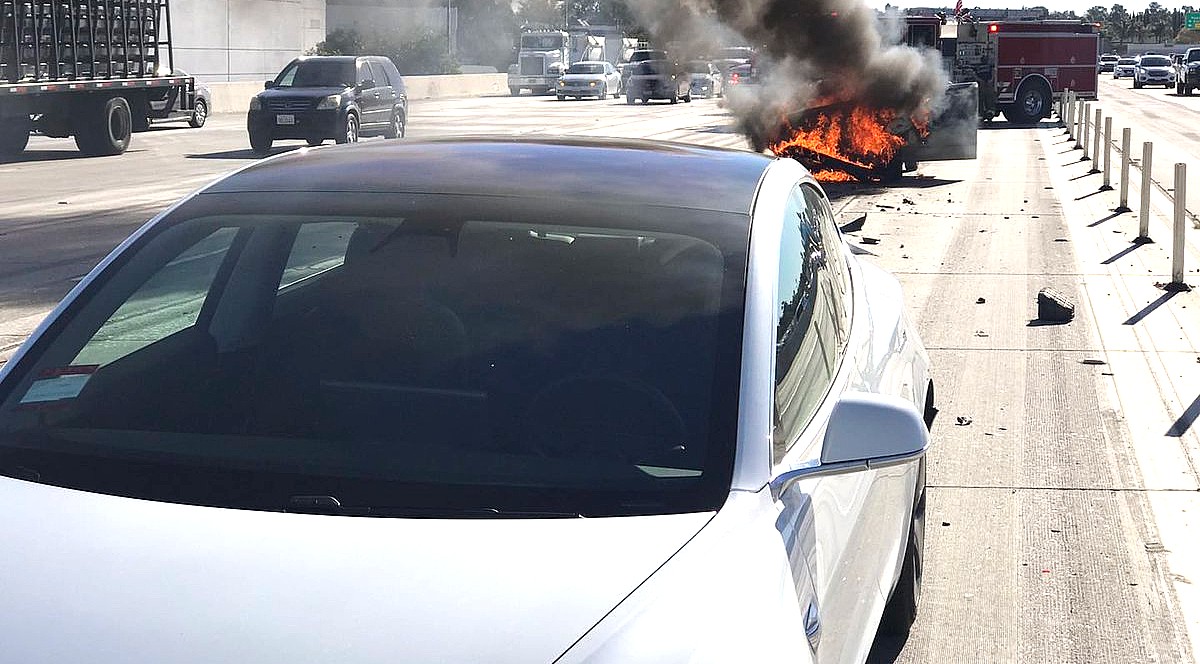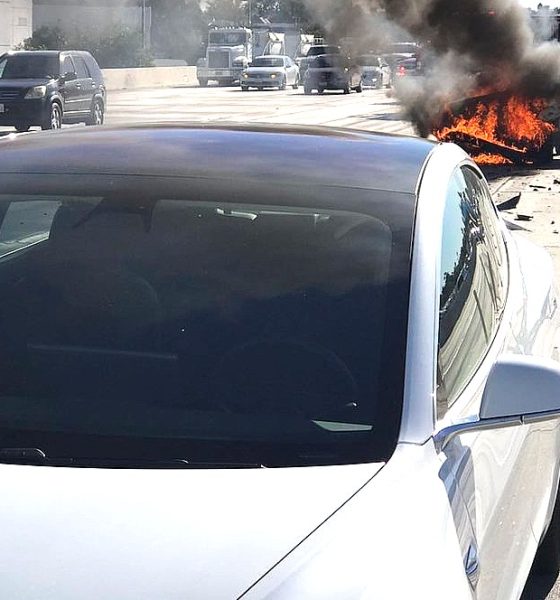

News
Tesla vehicles are 8x less likely to be involved in fires, shows latest safety report
Tesla has released its vehicle safety report for the second quarter of 2019. Similar to previous quarters, the report showed that Teslas operating on Autopilot are less likely to meet accidents on the road compared to vehicles operating without the driver-assist system enabled. Tesla’s report this quarter also included statistics on vehicle fires for the first time.
Fires involving Teslas are quite rare, with some quarters having recorded no vehicle fires at all. This, according to Tesla, results in some challenges, as an increase from one fire per quarter to two fires per quarter would result in a raise of 100%. Tesla has thus stated that it will provide annual vehicle fire data to avoid a misrepresentation of numbers and assure a meaningful comparison to the industry average.
The electric car maker’s data shows that between 2012-2018, there was approximately one Tesla vehicle fire for every 170 million miles traveled. Considering that the National Fire Protection Association (NFPA) and the US Department of Transportation record one vehicle fire for every 19 million miles traveled, Tesla’s figures make its electric cars over eight times less likely to be involved fires.
It should also be noted that Tesla’s vehicle fire statistics for 2012-2018 are not exclusive to incidents where the electric cars actually catch fire. Instead, Tesla’s data includes incidents resulting from structure fires, arson, and several other factors unrelated to the vehicles themselves.
Tesla’s Q2 2019 vehicle safety report also showed one accident for every 3.27 million miles driven with Autopilot engaged. Vehicles without Autopilot but have Tesla’s active safety features engaged, on the other hand, recorded one accident for every 2.19 million miles driven. Cars operating with no Autopilot and active safety features enabled recorded one accident every 1.41 million miles.
These figures are an improvement to Tesla’s first-quarter results, when the company recorded one accident for every 2.87 million miles driven on Autopilot, 1.76 million miles driven with active safety features but no Autopilot, and 1.26 million miles driven with no Autopilot and active safety features enabled. These results, while below the figures for the second quarter, are still notably superior to the NHTSA’s data, which currently stand at one accident for every 498,000 miles driven.
Tesla’s electric cars are among the safest vehicles on the road. The Model 3, for example, has earned stellar safety ratings from both the NHTSA and the Euro-NCAP, where the electric sedan set a new benchmark for safety. The Model 3 was granted a perfect 5-Star rating by the Euro NCAP in all four of its safety tests’ categories: Adult Occupant Protection, which tests how the vehicle protects its driver and passenger; Child Occupant Protection, which gauges the protection of younger occupants; Vulnerable Road Users, which tests a vehicle’s safety features for cyclists and pedestrians; and Safety Assist, which evaluates a car’s active safety capabilities.
Tesla’s Q2 2019 vehicle safety report could be read below.
Accident Data
In the 2nd quarter, we registered one accident for every 3.27 million miles driven in which drivers had Autopilot engaged. For those driving without Autopilot but with our active safety features, we registered one accident for every 2.19 million miles driven. For those driving without Autopilot and without our active safety features, we registered one accident for every 1.41 million miles driven. By comparison, NHTSA’s most recent data shows that in the United States there is an automobile crash every 498,000 miles.
Vehicle Fire Data
Tesla vehicle fires are exceptionally rare events, and in some cases, there have been zero Tesla vehicle fires in a quarter. That means that an increase from one fire per quarter to two per quarter represents an increase of 100%. In order to avoid misinterpretation of these numbers and provide a meaningful comparison to industry data, Tesla will publish an update to vehicle fire data annually.
From 2012 – 2018, there has been approximately one Tesla vehicle fire for every 170 million miles traveled. By comparison, data from the National Fire Protection Association (NFPA) and U.S. Department of Transportation shows that in the United States there is a vehicle fire for every 19 million miles traveled.
In order to provide an apt comparison to NFPA data, Tesla’s data set includes instances of vehicle fires caused by structure fires, arson, and other things unrelated to the vehicle, which account for about 15% of Tesla vehicle fires over this time period.

News
Tesla dominates in the UK with Model Y and Model 3 leading the way

Tesla is dominating in the United Kingdom so far through 2025, and with about two weeks left in the year, the Model Y and Model 3 are leading the way.
The Model Y and Model 3 are the two best-selling electric vehicles in the United Kingdom, which is comprised of England, Scotland, Wales, and Northern Ireland, and it’s not particularly close.
According to data gathered by EU-EVs, the Model Y is sitting at 18,890 units for the year, while the Model 3 is slightly behind with 16,361 sales for the year so far.
The next best-selling EV is the Audi Q4 e-tron at 10,287 units, lagging significantly behind but ahead of other models like the BMW i4 and the Audi Q6 e-tron.
GOOD NEWS 🇬🇧 Tesla is absolutely crushing the UK electric vehicle market in 2025 💥
The numbers are in, and the dominance is clear. With an impressive amount of 42,270 vehicles delivered year-to-date, the brand now commands a solid 9.6% market share of the total auto market 🆒… pic.twitter.com/dkiGX9kzd0
— Ming (@tslaming) December 18, 2025
The Model Y has tasted significant success in the global market, but it has dominated in large markets like Europe and the United States.
For years, it’s been a car that has fit the bill of exactly what consumers need: a perfect combination of luxury, space, and sustainability.
Both vehicles are going to see decreases in sales compared to 2024; the Model Y was the best-selling car last year, but it sold 32,610 units in the UK. Meanwhile, the Model 3 had reached 17,272 units, which will keep it right on par with last year.
Tesla sold 50,090 units in the market last year, and it’s about 8,000 units shy of last year’s pace. It also had a stronger market share last year with 13.2 percent of the sales in the market. With two weeks left in 2025, Tesla has a 9.6 percent market share, leading Volkswagen with 8 percent.
The company likely felt some impact from CEO Elon Musk’s involvement with the Trump administration and, more specifically, his role with DOGE. However, it is worth mentioning that some months saw stronger consumer demand than others. For example, sales were up over 20 percent in February. A 14 percent increase followed this in June.
News
Tesla Insurance officially expands to new U.S. state
Tesla’s in-house Insurance program first launched back in late 2019, offering a new way to insure the vehicles that was potentially less expensive and could alleviate a lot of the issues people had with claims, as the company could assess and repair the damage itself.

Tesla Insurance has officially expanded to a new U.S. state, its thirteenth since its launch in 2019.
Tesla has confirmed that its in-house Insurance program has officially made its way to Florida, just two months after the company filed to update its Private Passenger Auto program in the state. It had tried to offer its insurance program to drivers in the state back in 2022, but its launch did not happen.
Instead, Tesla refiled the paperwork back in mid-October, which essentially was the move toward initiating the offering this month.
BREAKING: Tesla Insurance has just officially launched in Florida.
This is the first new state to receive @Tesla Insurance in more than 3 years. In total, Tesla insurance is now available in 13 U.S. states (map in thread below of all the states).
Tesla Insurance in Florida uses… pic.twitter.com/bDwh1IV6gD
— Sawyer Merritt (@SawyerMerritt) December 17, 2025
Tesla’s in-house Insurance program first launched back in late 2019, offering a new way to insure the vehicles that was potentially less expensive and could alleviate a lot of the issues people had with claims, as the company could assess and repair the damage itself.
It has expanded to new states since 2019, but Florida presents a particularly interesting challenge for Tesla, as the company’s entry into the state is particularly noteworthy given its unique insurance landscape, characterized by high premiums due to frequent natural disasters, dense traffic, and a no-fault system.
Annual average premiums for Florida drivers hover around $4,000 per year, well above the national average. Tesla’s insurance program could disrupt this, especially for EV enthusiasts. The state’s growing EV adoption, fueled by incentives and infrastructure development, aligns perfectly with Tesla’s ecosystem.
Moreover, there are more ways to have cars repaired, and features like comprehensive coverage for battery damage and roadside assistance tailored to EVs address those common painpoints that owners have.
However, there are some challenges that still remain. Florida’s susceptibility to hurricanes raises questions about how Tesla will handle claims during disasters.
Looking ahead, Tesla’s expansion of its insurance program signals the company’s ambition to continue vertically integrating its services, including coverage of its vehicles. Reducing dependency on third-party insurers only makes things simpler for the company’s automotive division, as well as for its customers.
News
Tesla Full Self-Driving gets sparkling review from South Korean politician
“Having already ridden in an unmanned robotaxi, the novelty wasn’t as strong for me, but it drives just as well as most people do. It already feels like a completed technology, which gives me a lot to think about.”

Tesla Full Self-Driving got its first sparkling review from South Korean politician Lee So-young, a member of the country’s National Assembly, earlier this week.
Lee is a member of the Strategy and Finance Committee in South Korea and is a proponent of sustainable technologies and their applications in both residential and commercial settings. For the first time, Lee was able to utilize Tesla’s Full Self-Driving technology as it launched in the country in late November.
Her thoughts on the suite were complimentary to the suite, stating that “it drives just as well as most people do,” and that “it already feels like a completed technology.”
드디어 오늘, 서울에서 테슬라 FSD 체험 했습니다.
JiDal Papa님의 모델S 협찬에 힘입어^^ 파파님 정말 감사합니다.
국회 -> 망원시장 -> 홍익대 -> 국회 복귀 코스였고요.
이미 무인 로보택시를 타봐서 그런지 신기함은
덜했지만, 웬만한 사람만큼 운전을 잘하네요.이미 완성된 기술이라고… pic.twitter.com/8pAidHBpRG
— 이소영 국회의원 (Soyoung Lee) (@im_soyounglee) December 17, 2025
Her translated post says:
“Finally, today I got to experience Tesla FSD in Seoul. Thanks to the Model S sponsored by JiDal Papa^^, I’m truly grateful to Papa. The route was from the National Assembly -> Mangwon Market -> Hongik University -> back to the National Assembly. Having already ridden in an unmanned robotaxi, the novelty wasn’t as strong for me, but it drives just as well as most people do. It already feels like a completed technology, which gives me a lot to think about. Once it actually spreads into widespread use, I feel like our daily lives are going to change a lot. Even I, with my license gathering dust in a drawer, don’t see much reason to learn to drive a manual anymore.”
Tesla Full Self-Driving officially landed in South Korea in late November, with the initial launch being one of Tesla’s most recent, v14.1.4.
It marked the seventh country in which Tesla was able to enable the driver assistance suite, following the United States, Puerto Rico, Canada, China, Mexico, Australia, and New Zealand.
It is important to see politicians and figures in power try new technologies, especially ones that are widely popular in other regions of the world and could potentially revolutionize how people travel globally.








